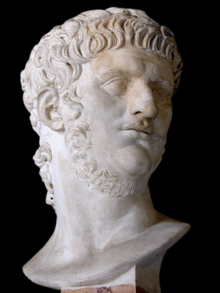The Romans (Doctor Who)
The Romans was envisioned as the first Doctor Who serial with a humorous tone, originally intended to parody the 1951 film Quo Vadis.
En route to Rome, the Doctor is mistaken for a murdered lyre player named Maximus Pettulian (Bart Allison), and decides to assume his identity after being attacked by an assassin.
Ian and Barbara are reunited and escape back to the villa as the Doctor and Vicki watch the city burn from a nearby hill.
The concept of a Doctor Who serial set in ancient Rome originated during the planning of the show's second season in early 1964; in April, it was allocated four episodes under the description "Roman".
[5] The production team decided that it would use The Romans and its preceding episode, The Rescue, to introduce new companion Vicki following the departure of Carole Ann Ford as Susan Foreman; The Rescue was written by outgoing script editor David Whitaker as a two-part introductory story, and The Romans was written by new script editor Dennis Spooner as a further establishing adventure.
[7] Barry soon contacted Antonio Maria Colini of the Museum of Roman Civilisation to discover more information regarding Nero's ruling of Italy.
Derek Francis who played Nero, was a friend of Jacqueline Hill and her husband Alvin Rakoff; he had been promised a role in Doctor Who since it started.
[20] The third episode received a smaller audience of 10 million viewers, attributed to its broadcast in the wake of the televised funeral of Winston Churchill.
[20] A journalist for The Times called Doctor Who "the strongest weapon in the BBC armoury", noting that The Romans "promises well" and describing the production as "once again flawless".
[21][22] At the BBC Programme Review Board, director of television Kenneth Adam praised Jacqueline Hill's performance in the second episode.
[21] An audience report prepared following the serial's broadcast was negative, with criticism directed at the show's historical episodes; several felt that it looked corny and amateurish, though the performances of Hartnell and Francis were praised.
In The Discontinuity Guide (1995), Paul Cornell, Martin Day, and Keith Topping wrote that "Hartnell shows the talent that got him the part", and praised the serial's atmosphere and comedy.
[23] In The Television Companion (1998), David J. Howe and Stephen James Walker felt that the episode is remembered "for its innovative use of humour", despite some historical inaccuracies.
[24] In A Critical History of Doctor Who (1999), John Kenneth Muir wrote that the serial's humour and wit set it apart from other historical stories, noting that it resonates where The Reign of Terror does not; he also praised the character development of Ian and Barbara, and Hartnell's comedic performance.
[26] In 2009, Cliff Chapman of Den of Geek found that the serial "does comedy well" with "witty dialogue, character moments, slapstick, and drama".
[27] DVD Talk's Stuart Galbraith IV praised the serial's ambition and uniqueness,[28] and Total Sci-Fi Online's Jonathan Wilkins called it a "genuine treasure" in which Hartnell displayed his comedic side.
Club noted that the story was less interested in historical accuracy but succeeded in comedy, praising the characterisation of the Doctor and Nero, the latter of whom he felt was "played to the hilt by Francis" by balancing the character's darker and lighter sides.
The novelisation was first published in hardback by WH Allen in April 1987, followed by paperback September 1987; both versions featured a cover painted by Tony Masero.
[28] The DVD includes audio commentary with William Russell, Nicholas Evans, Christopher Barry, and Toby Hadoke, as well as documentaries about the production, Spooner, and the show's female companions.
[36][37] The off-air soundtrack of The Romans was released by BBC Worldwide in May 2008, with linking narration by Russell; the CD also contained three radio spots, including an interview with Hartnell's granddaughter Jessica Carney.
